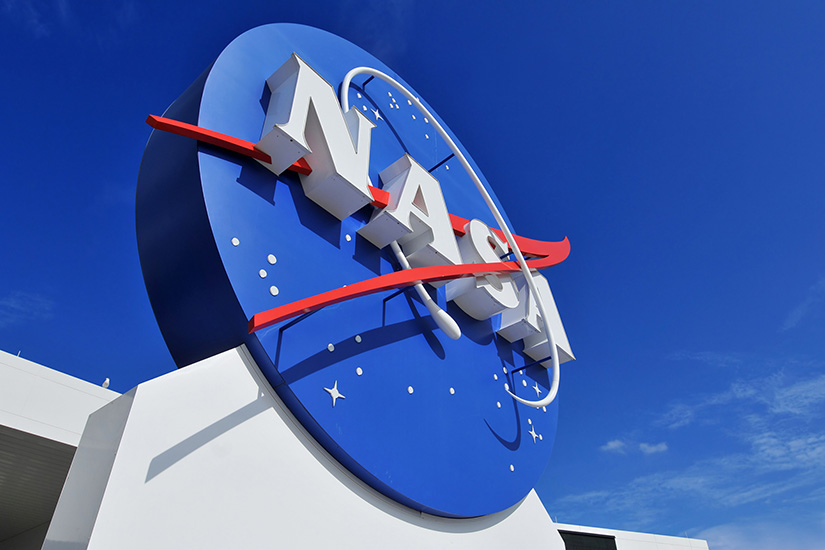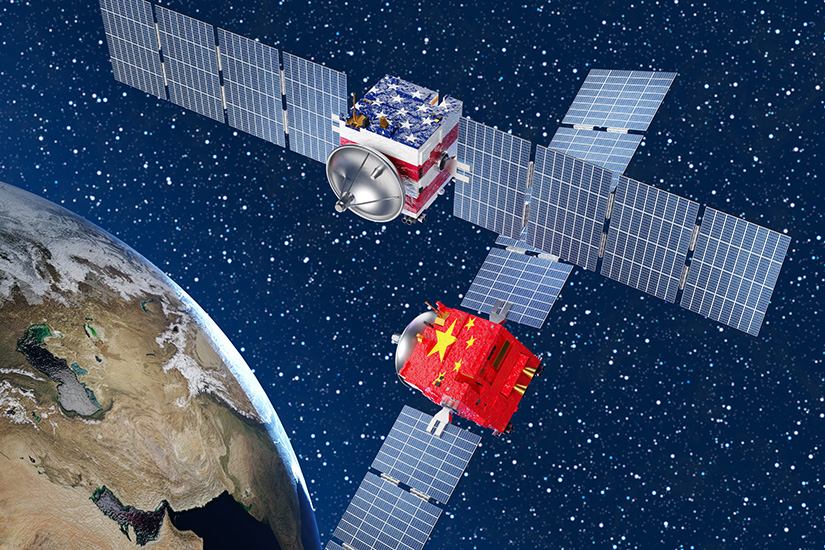NASA's Decline
U.S. space policy is facing new uncertainties under the Trump administration. In May 2025, the Trump administration passed the “One Big Beautiful Bill”—a massive legislation package including large-scale tax cuts — which requested substantial budget cuts and staff reductions for NASA, citing government efficiency as its goal. This sudden restructuring pressure on NASA led to the suspension of over 40 programs, including those monitoring the effects of climate change[1], potentially undermining the agency's ability to execute critical space science missions[2]. President Trump seeks to pursue organizational reform and efficiency at NASA by halting many ongoing space programs[3], while simultaneously focusing efforts on lunar exploration and planting the American flag on the planet Mars[4]. However, this not only foreshadows NASA's decline but also indicates a potential loss of America's identity as a leader in technological innovation and its international credibility.

Public-Private Collaboration in Space
Meanwhile, the conflict between President Donald Trump and Elon Musk over whether to suspend business orders for satellite launches, space transportation and resupply, and satellite communication systems from SpaceX, led by Musk, has revealed that government agencies such as NASA, the Space Force, and the National Reconnaissance Office(NRO) heavily rely on the private sector for space policy[5]. Driven by the evolution of space-related technologies and the growing utilization of private sectors, the government is increasingly relying on commercial companies like SpaceX—which offer high technical capabilities at lower cost—to save time and reduce expenses when addressing space competition. The role of startups capable of rapid decision-making in development is thus expanding, alongside legacy aerospace primes like Boeing in public-private sector cooperation in space. This signals a shift in the very business model of space-related ventures[6]. In this regard, President Trump expects that leveraging private sector capabilities will maximize reductions in development time and cost while sustaining innovation in related technologies. In August 2025, he signed an executive order easing regulations on satellite launches and recoveries by U.S. companies to encourage commercial space activities[7]. On the security front, the U.S. Department of War has formulated the “Commercial Space Integration Strategy” to advance government-private sector collaboration in space[8], and the U.S. Space Force also considers public-private partnerships essential for achieving space superiority[9].
China Seeks for Space Superiority
Since 1969, the United States has held the lead in planetary exploration and space cooperation as the nation that first landed humans on the moon. However, China, seeking strategic superiority in space, has rapidly increased its comprehensive presence in space by successively launching large-scale national projects, such as the lunar exploration program “Chang'e,” the space station “Tiangong,” and the satellite constellation “Qianfan”[10]. Militarily, China positions space as the strategic Commanding Heights[11] and is reorganizing the People's Liberation Army (PLA) to enhance its operational capabilities[12] and improve operational decision-making and interoperability[13]. The United States, which has maintained a dominant position in space, has become increasingly concerned about China's centralized and exclusive moves to secure space superiority[14].

The Intensifying Space Race
If the current confusion in U.S. space policy and the stagnation of its plans persist and America's international space partners fall behind in responding to this situation, China's strategic advantage in the space domain could accelerate significantly[15]. As the space domain becomes bipolar, global attention will be focused on U.S.-China competition for lunar exploration and development[16]. On the lunar surface, the U.S.-led Artemis program and China's proposed International Lunar Research Station (ILRS) program are progressing in parallel[17]. Both nations appear to be competing to establish access to lunar resources, secure technological superiority, and establish political dominance by deploying permanent space infrastructure on the Moon. This demonstrates that the lunar surface is transforming into a stage for geopolitical and technological competition[18].Furthermore, both the US and China position these lunar exploration initiatives and development efforts not as end goals, but as milestones in programs to expand human activity into deep space, including Mars. Consequently, the US-China space race centered on the lunar surface is likely to intensify[19]
Japan's Response
In light of the ongoing development of a US-China bipolar structure in space, Japan, which places great importance on its strong partnership with the United States[20], should strengthen the independence of its space activities[21]and further promote public-private collaboration and international cooperation. In particular, Japan considers the continued pursuit of technological innovation beyond the Moon toward Mars and deep space exploration, as well as maintaining and expanding mutually complementary international collaboration, to be strategic space objectives for its own growth and development[22]. Furthermore, as global investment in and dependence on space resources increase[23], Japan must acutely recognize the importance of managing these space assets. It is paramount Japan takes the lead in establishing international norms and rules[24], while also promoting security measures for its defense and protection[25].
In the space security domain, urgent action is needed to address the escalating risks and threats, such as orbital congestion, anti-satellite (ASAT) weapon attacks, and cyberattacks targeting space assets. In July 2025, Japan’s Ministry of Defense published the “Space Domain Defense Guidelines”[26], outlining the direction of space defense policy under the evolving security environment. This guideline follows the National Security Strategy approved by the Cabinet in 2022 and the subsequent Space Security Initiative[27], and is effectively the first policy document on space defense that includes concrete measures for protecting space assets and countering threats from space. Under these guidelines, Japan must pursue strategic responses that go beyond lunar activities toward deep space exploration. This involves aligning with existing frameworks like the “Basic Plan on Space Policy” and the “Act on the Promotion of Business Activities for the Exploration and Development of Space Resources”, materializing dual-use technologies and private-sector innovations into deployable advanced space equipment, and actively participating in multilateral space security frameworks such as the Combined Space Operations (CSpO)[28].

(2025/10/06)
Notes
- 1 Paul Voosen, “Dozens of active and planned NASA spacecraft killed in Trump budget request,” American Association for the Advancement of Science, May 30, 2025.
- 2 Jeff Foust, “Nearly 4,000 NASA employees opt for voluntary buyouts,” Space News, July 26, 2025.
- 3 The White House, Presidential Message on Space Exploration Day, July 20, 2025.
- 4 Tariq Malik, “The US will 'plant the American flag on the planet Mars and even far beyond’, Trump tells Congress,” Space.com, March 5, 2025.
- 5 Christopher Plain, “The NRO and the U.S. Space Force Just Conducted Another Secret Launch,” The Debrief, April 23, 2025.Not only did it become apparent that government space agencies rely increasingly on public-private partnerships, it also became clear that options other than SpaceX were extremely limited for future major space projects(“Trump administration ordered review of SpaceX government contracts following Trump-Musk fallout: Report,” The Economic Times, July 20, 2025.
- 6 Davide Vittori et al. “Failure is an option: How failure can lead to disruptive innovations,” Technovation Volume 129, January 2024.
- 7 The White House, “Enabling Competition In The Commercial Space Industry,” August 13, 2025.
- 8 U.S. Department of War, “DoD Releases 2024 DoD Commercial Space Integration Strategy,” April 2, 2024.
- 9 Emmeline James, “Saltzman details Space Force's international partnership strategy at Space Symposium,” United States Space Force, April 10, 2025.
- 10 Ryan Chan, “China Announces Breakthrough in Planned Moon Landing,” Newsweek, August 08, 2025.
- 11 Corey Crowell and Sam Bresnick, “Defending the Ultimate High Ground : China’s Progress Toward Space Resilience and Responsive Launch,” Center for Security and Emerging Technology, July 2023.
- 12 United Spates Space Force, “Testimony of General B. Chance Saltzman Chief of Space Operations United States Space Force,” U.S.-China Economic and Security Review Commission, April 3, 2025.
- 13 Joel Wuthnow, “A New Step in China’s Military Reform,” Joint Force Quarterly, April 17, 2025.
- 14 Ruxandra Iordache, “Investing in Space: The U.S.-China space race is getting tighter,” CNBC, Augst 22, 2025.
- 15 Amir Husain,” China’s Fast Growing Military Space Capabilities,” Forbes, November 14, 2024.
- 16 Gioia Rau, “Space, AI technology, and the future of Transatlantic security,” Aspenia Online, August 2, 2025.
- 17 Unlike the state-led and centralized ILRS, the Artemis program is characterized by a decentralized, commercially driven coalition that relies on the private sector to increase speed and reduce costs(Pablo Villar Bolaños, “China’s Steady Ascent to the Moon: How Beijing Is Rewriting Lunar Geopolitics,” The Diplomat, July 02, 2025.
- 18 Gioia Rau, “Space, AI technology, and the future of Transatlantic security,” Aspenia Online, August 2, 2025.
- 19 Ewa Fronczak, “China Vs US Space Race,” DailyExcelsior, August 18, 2025.
- 20 Japan and the United States have confirmed a strong partnership for human lunar exploration through cooperation on (1) the placement of U.S. payloads on Japan's Quasi-Zenith Satellites, (2) the consideration of sustainability initiatives through the Japan-U.S.-Australia-India (Quad) Space Working Group, and (3) the provision of lunar gateway equipment and lunar rovers as part of the Artemis program(MOFA, “United States-Japan Joint Leaders’ Statement,” February 7, 2025
- 21 Strategic Headquarters for National Space Policy,“The Basic Space Law,” June 13, 2024.
- 22 Oscar Escobar, “US-Japan Space Cooperation in the Artemis Generation,” East-West Center, July 9, 2024.
- 23 Julia Balm, “Space Dependence: a need for better communication,” King’s College London, February 9, 2024.
- 24 Japan has positioned space debris countermeasures as a common issue for the international community through the United Nations Committee on the Peaceful Uses of Outer Space (COPUOS), and has been proactive in promoting the need for technological development, domestic legislation, and the establishment of international guidelines(Sho Funakoshi, “Japan to Lead Charge on International Rules for Space Debris Removal; U.K., N.Z., Developing Countries Eyed as Partners,” The Japan News, June 20, 2025.
- 25 Swaim Prakash Singh, “Why Nations are Rallying Behind the Artemis Accords,” CAPSS, December 23, 2024.
- 26 Jesse Johnson, “‘Killer satellites’ beware: Japan unveils first space defense guidelines,” The Japan Times, July 29, 2025.
- 27 The Space Development Strategy Headquarters, Japan, ”Space Security Initiative,” June 2023.
- 28 MOD, “Combined Space Operations (CSpO) Initiative participation,” December 5,2023.

